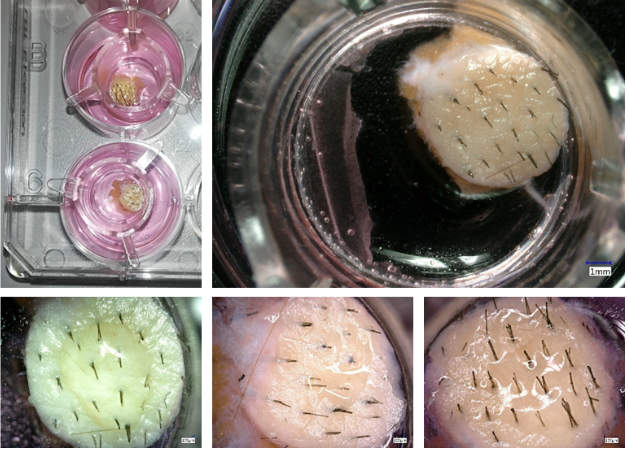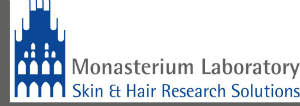

Monasterium Laboratory uses human skin for a range of ex-vivo assays to study this organ in health and disease.
Its well-established collaboration network of plastic surgeons and dermatologists provide human skin samples from several body sites, including the scalp, leg, abdomen and breast, from healthy individuals or patients with skin diseases, ranging from psoriasis to atopic dermatitis.
These skin samples allow Monasterium Laboratory to perform systemic or topical compound application in ex-vivo assays using a variety of well-established culture methods.
- Full-thickness human skin organ culture
- Wound healing human skin organ culture
- Long-term full-thickness skin organ culture (skin-reinnervation)
- Modelling of pathological conditions, such as ultraviolet (UV) irradiation, oxidative stress, psoriasis and atopic dermatitis
- Analysis of pigmentation, immune activity, stem cell compartments, epithelial integrity
- Isolation of primary cell lines from whole skin sections, such as dermal fibroblast, keratinocytes and melanocytes
Preclinical human hair follicle culture models
Monasterium Laboratory uses hairy human skin and microdissected human hair follicles for a range of ex-vivo assays to study this organ in health and disease.
The company uses different microdissection techniques on hair follicles isolated from human scalp skin or follicular units to allow the routine culture of:
- Microdissected human hair follicle
- Full-length hair follicle
- Entire follicular units.
Hair follicles are cultured ex-vivo in a serum-free defined medium to allow a large array of hair, pigmentation, cell cycle and stem cell parameters to be assessed.
Besides exploring mechanisms of action of test compounds (by administering pharmacological antagonists or neutralising antibodies), Monasterium Laboratory is also experienced in gene silencing by small interfering ribonucleic acid (siRNA) in human skin organ culture.
In addition, the company can perform a comparative analysis of healthy and diseased hair follicles in situ and modelling of pathological conditions such as oxidative stress, immune privilege collapse, chemo-induced alopecia, scarring alopecia.
In-situ analysis and histopathology services
Monasterium Laboratory provides in-situ analysis of human and murine skin and hair follicles, including the analysis of skin and hair follicle phenotype in knockout and wild-type mice.
The analysis includes specialised diagnostic services in human skin and hair follicle histopathology, as well as a range of techniques for measuring marker expression.
This service can also be provided in conjunction with laser capture microdissection for isolation of specific compartments for analysis by next-generation sequencing.
Custom services
Monasterium Laboratory offers a wide range of customised services in dermatology to help its customers achieve their research and development (R&D) goals.
Custom services include the development of new, cutting-edge preclinical skin and hair research assays; culture techniques; and analysis methodology.
Murine skin and hair culture models
Murine skin is an excellent model to study the effect of compounds and drugs on mammalian hair follicle cycling, skin homeostasis, stem cell regeneration and immune privilege.
Monasterium Laboratory has vast experience of comparative analysis of test substances in knock-out versus wild-type murine skin/hair follicles in organ-culture.
Vibrissae hair follicles (whiskers) are an excellent model to study stem cell regeneration and hair follicle biology, including complete hair follicle cycling ex-vivo. The company has significant expertise in using this ex-vivo model system in preclinical analyses of candidate drugs, cosmeceuticals and nutraceuticals.

